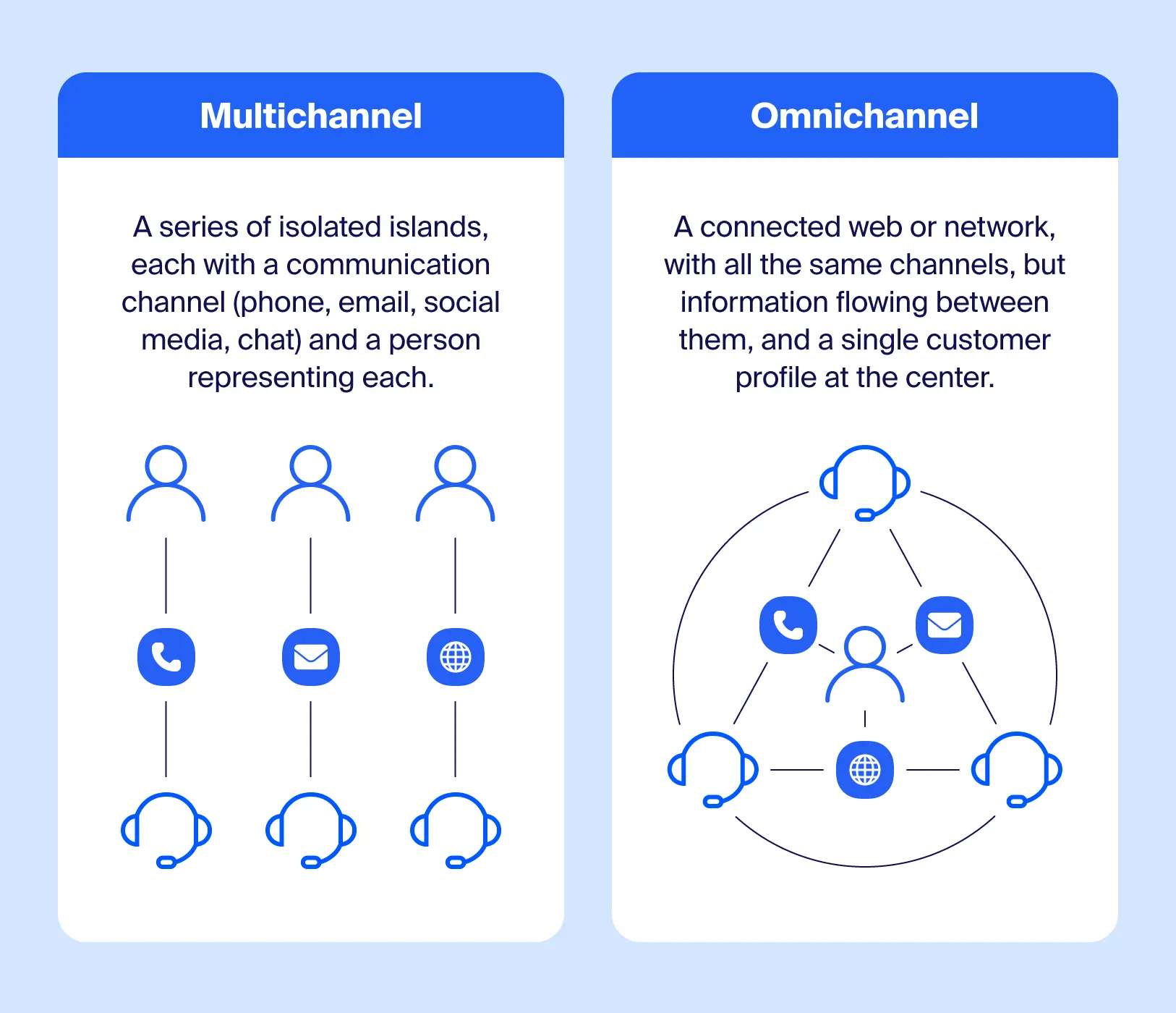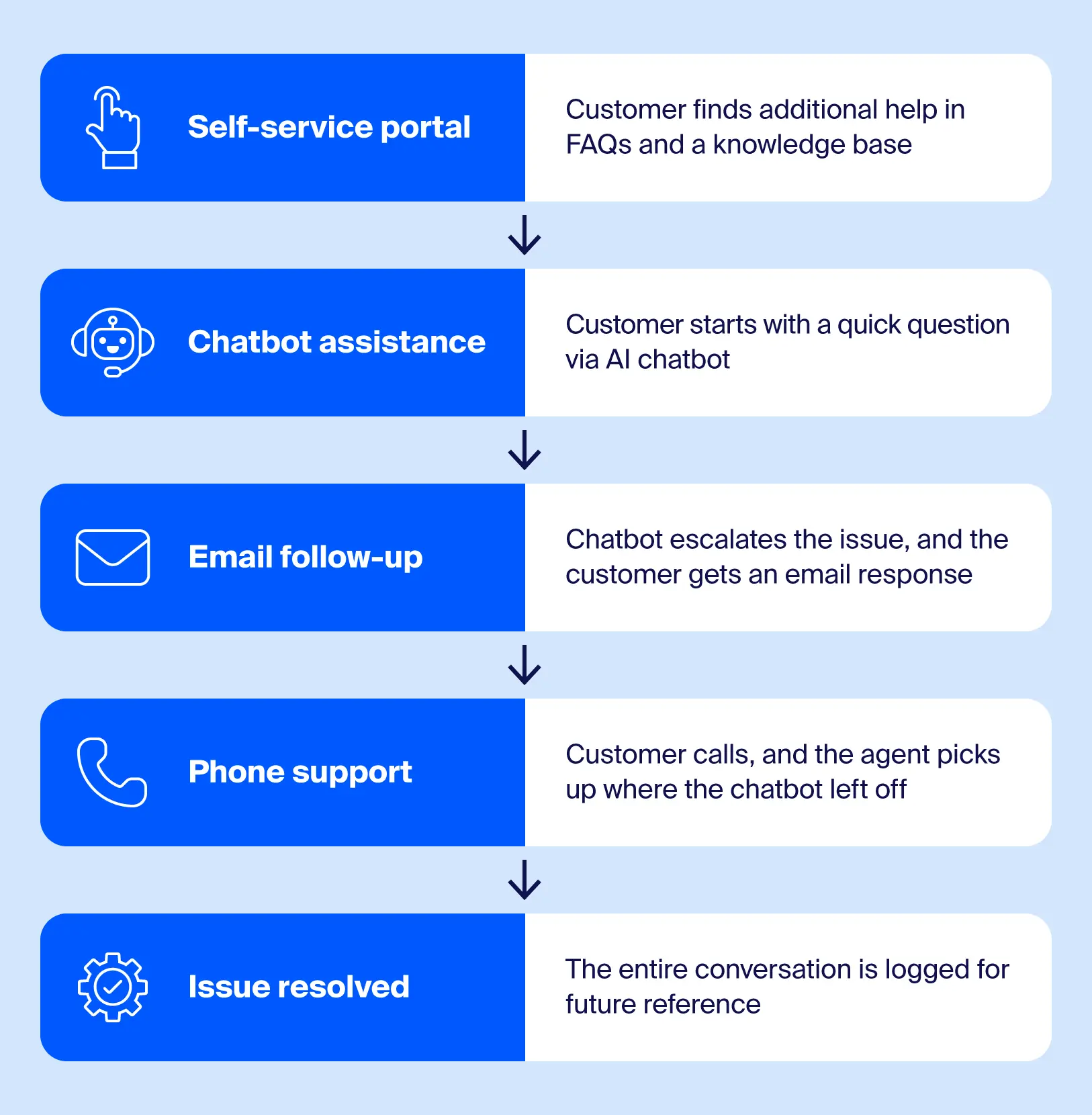
Meet Zoom AI Companion, your new AI assistant!
Boost productivity and team collaboration with Zoom AI Companion, available at no additional cost with eligible paid Zoom plans.
Updated on April 21, 2025
Published on April 21, 2025


Great customer support isn’t just about solving problems — it drives business. According to recent research Zoom commissioned with Morning Consult, 26% of consumers in 2024 would leave a brand after one poor interaction. But delivering that kind of seamless, consistent service across multiple channels? That’s where many businesses struggle.
With omnichannel customer service, customers get a unified, frictionless experience, whether they contact you via phone, email, chat, or social media. Without it, support teams face disjointed interactions, longer resolution times, and frustrated customers.
In this guide, we’ll break down what omnichannel customer service is, its benefits, key challenges, and how to implement it effectively so you can deliver the kind of support that drives loyalty and revenue.
Omnichannel customer service is a connected, integrated approach to customer support that integrates all communication channels — phone, email, chat, social media, and more — into a single, seamless experience.
Unlike multichannel support, where each channel operates independently, omnichannel ensures that conversations flow smoothly across platforms without customers having to repeat themselves.
For CX managers, this approach leads to better efficiency, faster resolution times, and a more personalized customer experience. Agents have full visibility into past interactions, allowing them to provide relevant support while reducing friction for customers.

Customers expect fast, seamless support no matter how they reach out. Imagine a customer starts a conversation with a chatbot on your website, follows up via email, and later calls your support team. If each interaction exists in a silo, they’ll have to repeat their issue every time — leading to frustration and wasted time.
But with an omnichannel approach, agents can see the full conversation history, making support faster, more personalized, and friction-free.
For businesses, this means higher customer satisfaction, stronger brand loyalty, and increased efficiency. Omnichannel communication keeps customers engaged and more likely to return, while support teams work smarter with better context and fewer redundancies.
An effective omnichannel strategy doesn’t just improve customer support — it enhances the entire customer journey. By connecting interactions across multiple channels, businesses can create a smoother, more personalized experience that leads to higher satisfaction, better efficiency, and stronger brand consistency.
Customers want effortless support. When they can switch between channels without repeating themselves, they feel valued and heard. AI-powered chatbots can handle routine inquiries while handing off complex issues to live agents, keeping responses quick and personalized. A seamless experience builds trust, leading to higher satisfaction and long-term loyalty.
Disconnected channels slow down resolutions. An integrated system gives agents full visibility into past conversations so they can resolve issues faster without backtracking. Automating repetitive tasks like appointment scheduling or order tracking frees up agents to focus on higher-value interactions.
Inconsistent messaging weakens brand trust. Standardized templates, centralized knowledge bases, and unified workflows help maintain service quality across chat, phone, email, and social media. Since agents pull from the same knowledge base and use preset guidelines for tone and messaging, customers receive the same clear, professional response regardless of the channel.
Customer interactions generate valuable data, but siloed channels make tracking preferences difficult. An integrated system captures real-time insights, helping agents personalize support. For example, if a customer frequently asks about a product feature, agents can proactively share relevant resources, making support more helpful and engaging.
A successful omnichannel strategy connects multiple support channels into a seamless experience that can be consolidated into one view. Each channel plays a key role so customers receive fast, efficient, and personalized service.
Live chat provides real-time support for quick problem-solving, while AI-powered chatbots handle routine inquiries 24/7. Chatbots can answer FAQs, guide customers through troubleshooting, and escalate complex issues to human agents, improving response times and reducing agent workload.
Email remains a critical channel for handling detailed or non-urgent requests. A ticketing system helps organize, track, and prioritize emails so no request falls through the cracks. Automated responses can acknowledge inquiries instantly, setting clear expectations for resolution times.
Customers expect brands to be responsive on platforms like Facebook, Twitter, WhatsApp, and Instagram. Social media support enables businesses to handle public inquiries efficiently while using messaging apps for private, real-time conversations. Integrating these channels into a unified omnichannel system helps teams track and manage all interactions in one place.
Despite the rise of digital channels, phone support remains essential, especially for urgent or complex issues. Interactive voice response (IVR) systems help route callers to the right department or provide self-service options for quick resolutions. When integrated with other channels, phone support allows agents to pull up customer history, making conversations more efficient. If your support team handles payments, tying in a payment orchestration platform can make a big difference. It connects all your payment methods in one place and makes sure transactions flow smoothly, whether customers pay over the phone, through chat, or on your app. This way, agents can quickly check payment details or sort out billing questions without jumping between different systems, which keeps things moving and customers happy.
Many customers prefer to find answers on their own before reaching out for support. A well-organized knowledge base with FAQs, how-to guides, and troubleshooting articles empowers customers to resolve issues independently. AI-driven search functions and personalized recommendations make self-service even more effective, reducing support requests while improving customer experience.
Building a strong omnichannel strategy requires more than just adding new support channels — it’s about creating a seamless, connected experience across all customer touchpoints. Here’s how to do it effectively:
Before making changes, evaluate where your current support system stands. Identify which channels you already use, how well they integrate, and where customers experience friction.
Analyze response times, resolution rates, and customer feedback to pinpoint gaps. A simple way to assess maturity is by mapping the customer journey — where do interactions break down or require customers to repeat themselves? Use these insights to prioritize improvements.
Disconnected channels lead to inconsistent service. Invest in a customer engagement platform that consolidates interactions across various communication channels into a single dashboard. This allows agents to access customer history instantly, eliminating repetitive questions and improving response times. Look for systems that integrate with CRMs, help desks, and AI tools to create a full-picture view of every customer.
A seamless experience depends on well-trained agents who can navigate multiple channels effortlessly. Instead of siloing teams by channel, train agents to handle inquiries across different platforms with the same level of quality.
Provide hands-on training for tools like chat platforms, ticketing systems, and AI chatbots so agents can switch between them without disrupting the customer experience. Role-playing real-world scenarios can also help them practice managing complex cross-channel interactions.
AI-driven tools can reduce workload and improve response times by handling routine inquiries, routing conversations, and providing agents with real-time insights. Implement chatbots for FAQs and basic troubleshooting, set up automated workflows for ticket prioritization, and use AI-powered sentiment analysis to detect customer frustration early.
Automation doesn’t replace human support but enhances it, allowing agents to focus on high-value interactions that require a personal touch.

Here are some use cases with examples to understand omnichannel customer service in action.
Security and trust are essential in customer service, especially in industries like finance and healthcare, where customers share sensitive information. By routing verified customers directly to the right agent, businesses reduce friction while protecting customer data.
For example, a credit union can use an omnichannel contact center to authenticate a caller based on previous interactions, bypassing lengthy security questions and instantly connecting them to a financial specialist.
Keeping customers informed reduces frustration and improves satisfaction. With AI-powered automation, businesses can send real-time updates via SMS, email, or chat about order status, service outages, or appointment reminders.
A telecom provider, for instance, can automatically notify customers about upcoming billing due dates or network maintenance. If a customer replies with a question, the system can escalate the conversation to a live agent with full context for a smooth experience.
Customers expect to begin a conversation on one channel and continue it on another without the need to repeat themselves. Omnichannel customer service unifies interactions across SMS, chat, phone, and video so agents have full visibility into past conversations.
For example, a tech support team can allow a customer to start troubleshooting via live chat and, if needed, escalate to a voice or video call with the same agent — without losing conversation history. This reduces frustration, speeds up resolution, and improves customer satisfaction (CSAT) scores.
Different industries require tailored customer service solutions. Here’s how various industries can benefit from an omnichannel approach:
Contact us today to find out how Zoom Contact Center works with your unique needs to deliver tailored omnichannel solutions for every industry.
Implementing an omnichannel strategy comes with challenges, from integrating multiple systems to maintaining consistency across channels. Here’s how businesses can overcome these obstacles and deliver a seamless customer experience.
Many businesses struggle with disconnected support platforms, leading to fragmented customer data and inefficiencies. Without proper integration, agents lack a unified view of customer interactions, forcing customers to repeat themselves across different channels.
Solution: Omnichannel contact center software can centralize all interactions across chat, email, phone, and social media into a single platform. Seamless CRM, knowledge base, and support system integrations give agents full conversation history, allowing them to provide faster and more personalized support.
Customers expect the same level of service whether they contact support via chat, phone, email, or social media. But inconsistent messaging and response quality can damage trust and frustrate customers.
Solution: Standardized response templates, AI-driven suggestions, and a centralized knowledge base can help agents deliver uniform answers. With an omnichannel solution, businesses can create preset workflows and messaging guidelines, making sure customers receive the same quality of service across every channel.
While AI-powered chatbots and automated workflows improve efficiency, over-reliance on automation can lead to impersonal customer experiences and frustration when customers need human assistance.
Solution: Use AI-powered virtual agents to handle simple requests while smoothly transferring complex issues to live agents with full conversation history. This reduces wait times while providing customers the right level of support at every step.
Handling customer data across multiple channels introduces security risks and compliance challenges, especially in regulated industries like finance and healthcare. Businesses must protect sensitive information while providing seamless support.
Solution: Use contact center software with built-in security features like encrypted communications, role-based access controls, and compliance with industry regulations. AI-driven authentication methods, such as voice recognition and behavioral analytics, can help businesses quickly verify users while keeping interactions secure.
Omnichannel customer service isn’t just a trend — it’s the key to delivering seamless, efficient, and personalized support across every customer touchpoint. By integrating multiple channels, businesses can reduce friction, improve agent productivity, and enhance customer satisfaction.
With Zoom Contact Center, you get a cloud-based, AI-powered omnichannel solution that unifies interactions, streamlines workflows, and helps your team provide faster, smarter support.
Ready to transform your customer experience? Talk to a Zoom Contact Center expert today.
Omnichannel customer service boosts ROI by reducing operational inefficiencies, improving customer retention, and increasing sales. A seamless support experience leads to higher customer satisfaction, which directly impacts loyalty and repeat business.
AI-powered automation and self-service options lower costs by handling routine inquiries, freeing agents to focus on high-value interactions. Faster resolutions and reduced agent workload also contribute to cost savings and increased productivity.
Successful omnichannel customer service relies on a centralized contact center platform that integrates multiple communication channels, including chat, email, phone, and social media. AI-powered virtual agents help automate routine inquiries, while CRM integrations provide agents with full customer history for personalized support.
Other essential tools include ticketing systems, knowledge bases, IVR, and analytics dashboards for tracking customer interactions and service performance.
Omnichannel support simplifies workflows by giving agents a complete view of customer interactions across all channels. This reduces repetitive conversations and allows agents to provide faster, more personalized responses.
AI-driven assistance helps streamline tasks like note-taking and case routing, improving efficiency. With better data and real-time coaching tools, agents can focus on delivering higher-quality customer service while avoiding burnout from handling the same inquiries repeatedly.
Multichannel customer service allows customers to reach a business through multiple communication channels, but these channels often operate independently.
Omnichannel, on the other hand, connects all channels into a unified experience, allowing customers to switch between them seamlessly without losing context. This eliminates the need for customers to repeat themselves and provides agents with a full interaction history, resulting in faster resolutions and a more consistent support experience.